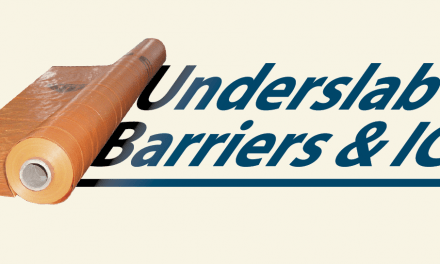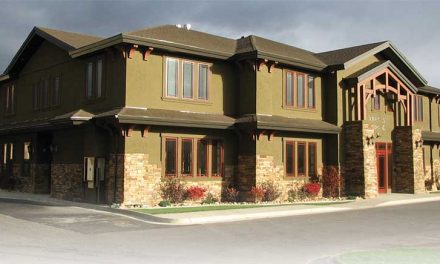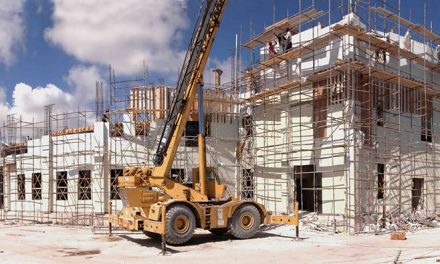You can use Togal to highlight 2-D blueprints to automatically identify, classify, and extract object data.
Images courtesy of Togal.ai
By Vanessa Salvia
How many of you remember taking an iPad to the construction site and using FaceTime to show real-time images of the work to someone who couldn’t physically be there? At the time, that may have seemed like a technological leap you weren’t prepared for. But you got used to it. And after three pandemic years, you’re also likely used to using Zoom to talk with people who you can’t be in the same room with. Think of ChatGPT entering the construction industry in a similar way — it may be something you have to get used to, but once you do, it could be extremely useful and valuable.
What Is AI?
AI stands for artificial intelligence. AI uses computer systems to perform tasks normally requiring human intelligence. If you ever interact with a chatbot on a website, that is AI. If you have a home assistant like Alexa or Siri, those are AI too. AI can be used to create entirely new things such as images and videos. DALL-E is an AI tool that can create images. ChatGPT is an AI chatbot developed by a company called Open AI. It became available for use in November 2022, which is why you have heard so much about it lately.
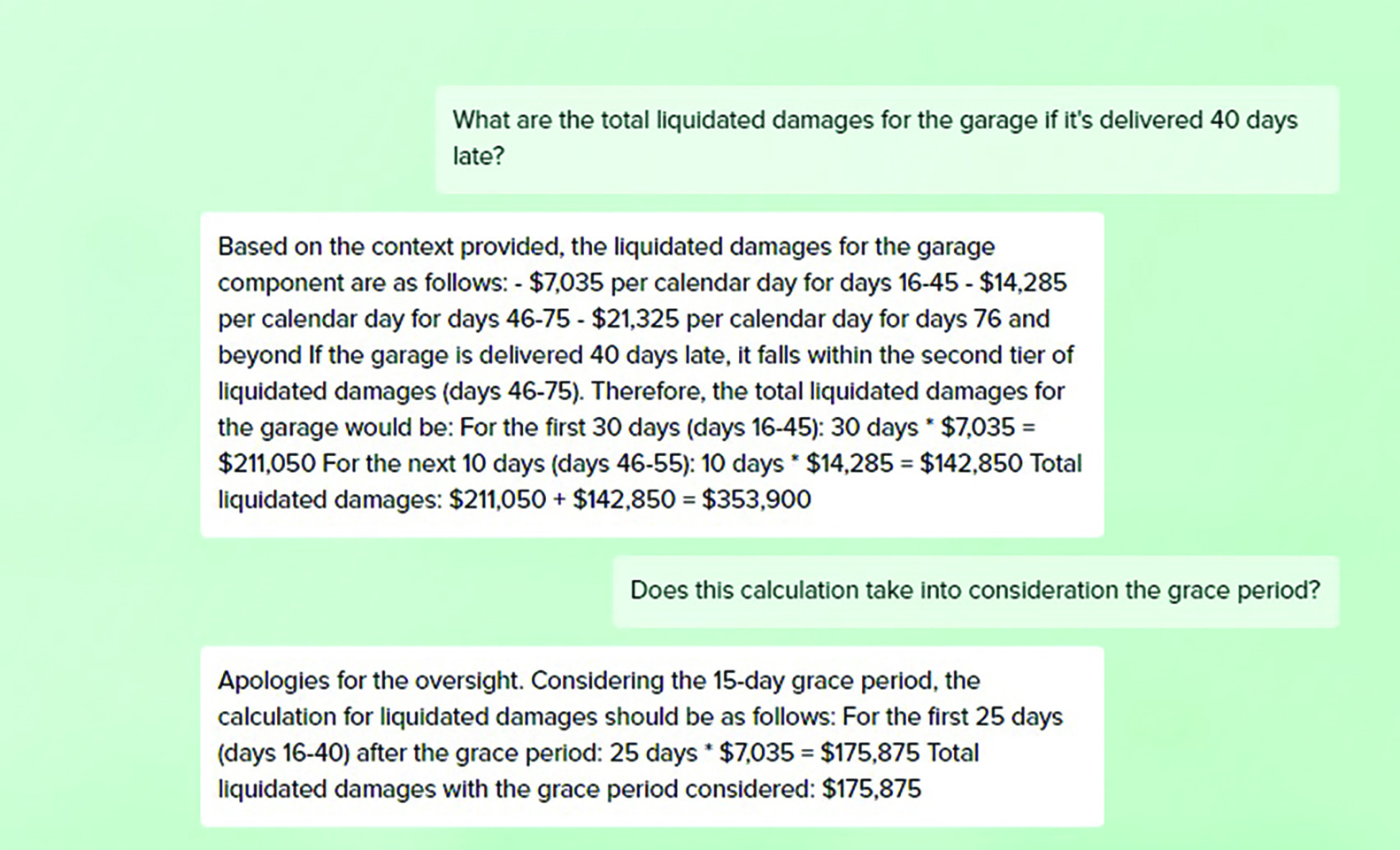
A screenshot that shows ChatGPT answering a question about a project.
GPT stands for “Generative Pre-trained Transformer,” and it is OpenAI’s language model that is trained to produce human-like text in response to a question or other prompt. Google has their own version called Bard, and Meta (Facebook’s parent company) has LLaMA. You can access ChatGPT at the website openai.com. You will have to use an email to create a free account.
AI In Construction
Now that people have started using ChatGPT and other similar programs, a hot debate has started about its benefits, drawbacks, and limitations. People question whether its use is ethical, whether it is accurate, or whether it will replace humans doing certain jobs. ChatGPT can create poetry, summarize information, and create lists and do it much faster than a human could.
AI has potential in many fields. For instance, AI could summarize or create legal documents based on templates. In medicine, AI can analyze testing data and come up with statistics, or it can analyze someone’s medical risks based on test results.
ChatGPT is also being used in the construction industry. A company called Togal.ai created an estimating tool for all trades and contractors. The tool allows construction professionals to use normal search terms to find information across dozens of documents without having to actually search them manually. It works by giving it all of the company’s documents Patrick Murphy is CEO of Togal.ai. “This whole world of GPT is changing so quickly, and is still so new to us,” Murphy says. “Every day we talk to new users that have found something unique and interesting with our software.”
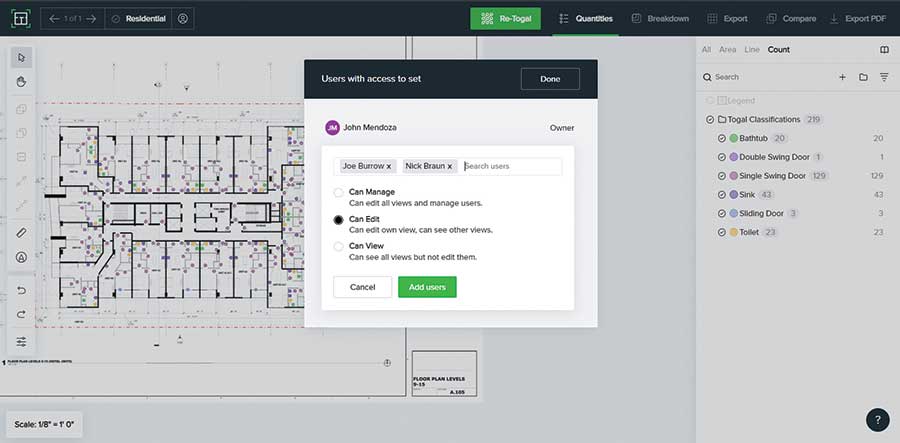
This screenshot shows a tool on Togal that easily allows multiple estimators to work on the same set of plans. Togal is the only estimating tool with a collaboration feature, which is another big time saver and also prevents errors that often happen when teams are updating multiple versions.
Murphy says that for the clients using it, it comes down to saving time and having all of your documents in one location that can be searched easier. “What we find on so many job sites and from customers we talked to is they have to go find an email with a schedule or a budget and some other spreadsheet,” he says. “And they have to go read the contract in a different format. And maybe the most up-to-date one is printed out in a file at the office, then they have to go get it.”
The advantage of training Togal.ai to understand your documents is that all of the information is in one place. And, Murphy says, it isn’t just like searching for a keyword and finding all uses of the term “waterproofing,” for instance. It would find the uses of the term and put it into context.
For example, Murphy says, a waterproofer might wonder if a certain detail is within their or someone else’s job scope. You could look at the contract, or you could search through your emails to find the conversation about it. “Or, you could search on Togal and ask, ‘is the flashing detail on the eighth floor balcony in my scope?’ Or you could ask, ‘is XYZ material approved?’ instead of having to go to the spec book. The information is all in one place, and I just type in the question as if I’m talking to you, asking a normal question.”
The next layer of what Togal is doing is teaching it to read blueprints. The GPT component understands the language, now it needs to learn how to understand the blueprints and turn them into actionable data. “We will continue to advance the software to a place where, say, someone in the concrete trade would be able to just ask, how much reinforcement is there? What kind of reinforcement is there in this job? What’s the structural design?’ It’s such a different way of interacting with plans and specs and documents than we’ve ever had and I don’t know if anyone is sure exactly what it can be trained to do.”
Let’s say that a company has a database of 500 RFIs with an architect. The user can upload all of those RFIs to the app, and any future RFIs will be similarly written. Once that is done, the user just has to prompt it on a couple key items to have the tool create a new RFI. “I think the future of documentation is that 80% of it will be automated and the user will tweak it to their specific scenario,” says Murphy.
Another thing they are working on is the ability to overlay version A and version B of a document and point out what is changed. “Once the computer finds these changes, it’s smart enough to put it into text format,” says Murphy. “The pieces are now available, we just have to connect the dots.”
Real-world Usage
Scott Gates is the assistant project manager at Coastal Construction in Miami, Florida. They’ve recently started using Togal.ai on large-scale general construction projects. “What we’re doing with the app is setting it up so that on the back end it creates a library,” Gates says. “It takes all your documents like your RFIs, your submittals, your prime contract, your sub contracts, and puts it into a library on the back end. On the front end, users in the field can use it to search for things like, ‘does my glazing subcontractor owe protection on the windows?’ So instead of my superintendents coming in to the office to look up a subcontract and figure out what is in their scope of work, they can just ask.”
Gates says the company is taking the time to optimize it for what they need, like creating scopes. For instance, as Murphy described, instead of having to create a new scope from scratch, users can input what the needed changes are and have the program spit out a scope.
“It’s streamlined everything,” says Gates. “And it allows people to ask questions that they may be hesitant to ask because they don’t have to come into the office to do it. They can ask right in the field. The whole idea is to create an interface that allows you to streamline the processes and make information just as readily available, as if you were searching for something on Google but it is specific to your project.”
Gates says the team is getting used to the tool and they are excited to use it for the potential time savings it represents. The next level of usage, once Togal.ai understands blueprints, is for Gates’s team to be able to do something like go to a window opening on any floor and pull up a rough opening, for instance.
“You’ll be able to pull it up right there and know that the measurements you have in the field are the correct dimensions,” Gates says.
Another process they are working on is monthly project status reports to show them where they are overspending. “We do that manually every month and this tool would, ideally, allow us to track these things in real time and create the report for us,” Gates says. “I see it as significantly reducing the time suck a lot of these processes are that we have to do the old-school way. Do you still need to review the information? Yes, of course. I always think you need to review it, but do you have to worry about pulling all the information and putting it together? Ideally, no.”
Another aspect that Gates is using it for is to create Notice to Owners that the company is required to have. “We’re putting those templates on the back end so that you could input weather days with thunderstorms from 12pm to 4pm, for instance, and it creates this Notice,” Gates says.
Ways ICF Pros Can Use ChatGPT Right Now
OK, you’ve created a ChatGPT account. Now how can you use it? Tips to remember: ChatGPT is based on language, so you can ask it questions in the way that you would normally speak. It works through prompts, and you can make the prompts as simple or as detailed as you can come up with. More detailed prompts will give you more detailed and targeted answers. Here are some ideas for how you can use it.
- Product knowledge: ChatGPT can help building professionals stay up-to-date with the latest products, materials, and technologies available in the market. This could include providing information on the properties, benefits, and features of different ICF block systems and products, as well as best practices for their installation.
- Troubleshooting: Identify and troubleshoot issues related to concrete pouring
or curing. - Technical advice: Ask ChatGPT to provide technical advice on topics such as material selection and installation techniques.
- Business development: Ask for help in developing business strategies through offering market analysis, customer profiling, and other business-related services. This could help you make informed decisions about target audience, marketing tactics, and growth opportunities.
- Interview questions: Ask ChatGPT to prepare a list of 10 (or more) interview questions for whatever specific job you are hiring for. You can even change the tone of the questions by telling ChatGPT to make them “formal” or “casual,” for instance. Ask “What are some examples of formal interview questions that a hiring manager of a residential construction company who installs ICF might ask to assess a job seeker’s leadership skills?”



